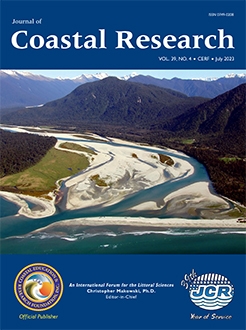Buzard, R.M.; Kinsman, N.E.M.; Maio, C.V.; Erikson, L.H.; Jones, B.M.; Anderson, S.; Glenn, R.J.T., and Overbeck, J.R., 2023. Barrier island reconfiguration leads to rapid erosion and relocation of a rural Alaska community. Journal of Coastal Research, 39(4), 625–642. Charlotte (North Carolina), ISSN 0749-0208.
Coastal erosion is one of the foremost hazards that circumpolar communities face. Climate change and warming temperatures are anticipated to accelerate coastal change, increasing risk to coastal communities. Most erosion hazard studies for Alaska communities only consider linear erosion and do not anticipate coastal morphologic changes. This study showcases the possibility and consequence of accelerated erosion by examining a shift from stability to rapid erosion that forced the rural Alaska Native village of Meshik (now Port Heiden) to abandon the original town site and relocate inland. A combination of remote sensing, coastal surveys, and community-based monitoring are used to map coastal morphologic changes and identify erosion drivers. The community's shoreline was stable until a protective barrier island eroded away. The exposure to open ocean waves, coupled with unconsolidated, low-density sediments, led to rapid erosion rates averaging 5.8 ± 0.6 m/y from the 1970s to 2020s. The sudden and rapid erosion put great stress on Meshik residents and resulted in the loss of homes, erosion of a safe boat harbor, and pollution of the beach and bay. Erosion of the barrier island coincided with a period of greater storm activity and sea ice decline, but the exact cause could not be determined. Many polar communities are built on or behind barriers and are on erodible soils such as sands and thawing permafrost. This study highlights the need to study, monitor, and predict morphologic change and regime shifts that can bring catastrophic impacts to coastal communities.





